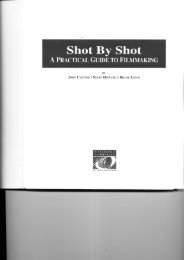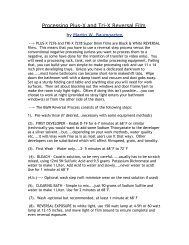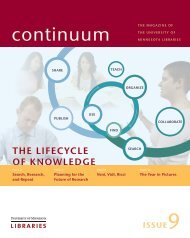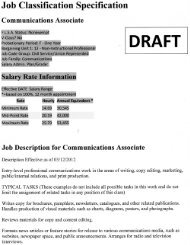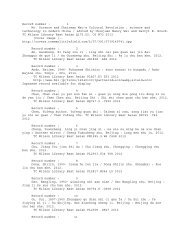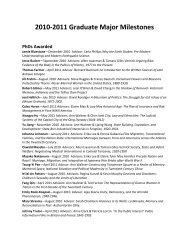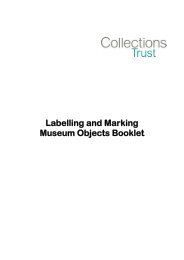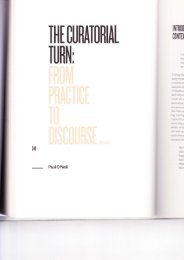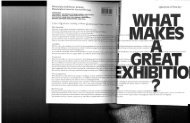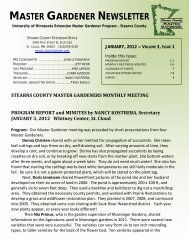Art in the Information Age: Technology and Conceptual Art
Art in the Information Age: Technology and Conceptual Art
Art in the Information Age: Technology and Conceptual Art
Create successful ePaper yourself
Turn your PDF publications into a flip-book with our unique Google optimized e-Paper software.
nology . . . tended to suffer from a trivial<br />
equation of ‘modernity’ with scientic<br />
<strong>and</strong> mechanical development. It tended<br />
also to be co-opted by <strong>the</strong> very representational<br />
technologies it set out to exploit”<br />
[22]. He also stated that dur<strong>in</strong>g this “time<br />
of E.A.T. . . . <strong>and</strong> of Cybernetic Serendipity<br />
. . . it seemed to some as if fasc<strong>in</strong>ation<br />
with design <strong>and</strong> technology might be signicantly<br />
<strong>in</strong>jected <strong>in</strong>to artistic modernism.<br />
The boot was on <strong>the</strong> o<strong>the</strong>r foot,<br />
however” [23]. Paraphras<strong>in</strong>g A&L cofounder<br />
Michael Baldw<strong>in</strong>, Harrison<br />
wrote that <strong>the</strong> “legacies of Pop-<strong>Art</strong>-<strong>and</strong>technology<br />
were never part of <strong>the</strong> <strong>Art</strong> &<br />
Language agenda,” [24] <strong>and</strong> fur<strong>the</strong>r<br />
claimed that <strong>the</strong>y never “furnished much<br />
better than chronic distractions from <strong>the</strong><br />
more <strong>in</strong>terest<strong>in</strong>g <strong>and</strong> <strong>in</strong>tractable problems<br />
of modern art” [25].<br />
Although Pop art <strong>and</strong> art-<strong>and</strong>technology<br />
<strong>in</strong>tersected at certa<strong>in</strong> po<strong>in</strong>ts,<br />
<strong>the</strong>y also represent two very different<br />
legacies. By collaps<strong>in</strong>g <strong>the</strong>m toge<strong>the</strong>r,<br />
Baldw<strong>in</strong> <strong>and</strong> Harrison reduce <strong>the</strong> unique<br />
qualities <strong>and</strong> goals of each to <strong>the</strong>ir least<br />
common denom<strong>in</strong>ator, namely <strong>the</strong> use<br />
of technology as a formal element<br />
wielded <strong>in</strong> <strong>the</strong> <strong>in</strong>terest of appeal<strong>in</strong>g to<br />
<strong>the</strong> masses. Indeed, Baldw<strong>in</strong> had <strong>in</strong> m<strong>in</strong>d<br />
<strong>the</strong> “art-democratised-as-light-shows-orcyberneticised-life-style<br />
mach<strong>in</strong>e” events<br />
of <strong>the</strong> UK group F<strong>in</strong>e <strong>Art</strong>z, with whom<br />
A&L co-founder David Ba<strong>in</strong>bridge was af-<br />
liated [26]. Burnham also denigrated<br />
<strong>the</strong> “chic superciality that surrounded<br />
. . . many of <strong>the</strong> k<strong>in</strong>etic performances<br />
<strong>and</strong> ‘light events,’” which he<br />
equated with <strong>the</strong> sensation of “<strong>the</strong> uptown<br />
disco<strong>the</strong>que” [27]. However, Burnham,<br />
be<strong>in</strong>g much more <strong>in</strong>terested <strong>in</strong> <strong>and</strong><br />
knowledgeable about art-<strong>and</strong>-technology,<br />
also recognized that its more <strong>the</strong>oretically<br />
sophisticated aspects—i.e. its concern<br />
with process <strong>and</strong> systems, <strong>the</strong><br />
relationship between technological <strong>and</strong><br />
aes<strong>the</strong>tic structures of knowledge, <strong>and</strong> an<br />
<strong>in</strong>teractive, two-way exchange of<br />
<strong>in</strong>formation—were closely related to central<br />
features of conceptual art.<br />
Despite his <strong>in</strong>difference to art-<strong>and</strong>technology,<br />
Harrison acknowledged <strong>the</strong><br />
<strong>in</strong>terest <strong>in</strong> technology shared by A&L<br />
found<strong>in</strong>g members Harold Hurrell <strong>and</strong><br />
David Ba<strong>in</strong>bridge. He described <strong>the</strong> former’s<br />
Cybernetic <strong>Art</strong>work that Nobody Broke<br />
(1969) [28] <strong>and</strong> <strong>the</strong> latter’s Lecher System<br />
(1969–1970) [29] as “ail<strong>in</strong>g about—<br />
products of <strong>the</strong> search for practical <strong>and</strong><br />
<strong>in</strong>tellectual tools which had not already<br />
been compromised <strong>and</strong> rendered euphemistic<br />
<strong>in</strong> Modernist use” [30]. But<br />
<strong>the</strong>re is much more to <strong>the</strong>se works than<br />
that. I suggest that <strong>the</strong>y, as well as Terry<br />
Atk<strong>in</strong>son <strong>and</strong> Baldw<strong>in</strong>’s 22 Sentences: The<br />
French Army (1967) [31], exemplify critical<br />
concerns at <strong>the</strong> heart of art-<strong>and</strong>technology.<br />
Hurrell’s spurious computer program<br />
for <strong>in</strong>teractively generat<strong>in</strong>g color refused<br />
to allow <strong>the</strong> user to <strong>in</strong>teract beyond <strong>the</strong><br />
rigid banality of b<strong>in</strong>ary <strong>in</strong>put. If <strong>the</strong> user<br />
<strong>in</strong>put a number o<strong>the</strong>r than 0 or 1, <strong>the</strong> program<br />
proffered <strong>the</strong> message: “YOU HAVE<br />
NOTHING, OBEY INSTRUCTIONS!” If<br />
<strong>the</strong> user <strong>in</strong>put a non-number, Cybernetic<br />
<strong>Art</strong> Work told him or her that <strong>the</strong>re was an<br />
“ERROR AT STEP 3.2.” Lecher System juxtaposed<br />
a “‘sculptural morphology’ <strong>and</strong><br />
an ‘electromagnetic morphology.’” The<br />
perceptual experience of <strong>in</strong>teract<strong>in</strong>g with<br />
<strong>the</strong> sculptural aspect of <strong>the</strong> system was <strong>in</strong>tended<br />
to result <strong>in</strong> knowledge about <strong>the</strong><br />
electromagnetic aspect of <strong>the</strong> system that,<br />
<strong>in</strong> turn, would create knowledge about<br />
<strong>the</strong> sculptural aspects. 22 Sentences <strong>in</strong>cluded<br />
a key to abbreviations for <strong>the</strong><br />
French Army (FA), <strong>the</strong> Collection of Men<br />
<strong>and</strong> Mach<strong>in</strong>es (CMM), <strong>and</strong> <strong>the</strong> Group of<br />
Regiments (GR), <strong>the</strong>n described <strong>the</strong><br />
<strong>in</strong>ter-relationships between <strong>the</strong>m:<br />
The FA is regarded as <strong>the</strong> same CMM as<br />
<strong>the</strong> GR <strong>and</strong> <strong>the</strong> GR is <strong>the</strong> same CMM as<br />
(e.g.) “a new order” FA (e.g. Morphologically<br />
a member of ano<strong>the</strong>r class of<br />
objects): by transitivity <strong>the</strong> FA is <strong>the</strong><br />
same CMM as <strong>the</strong> “New Shape/Order<br />
one.”<br />
This ironic passage reduced to absurdity<br />
<strong>the</strong> sort of systematic relationships<br />
between <strong>in</strong>dividuals, groups, <strong>and</strong><br />
<strong>in</strong>stitutions characteristic of cybernetics<br />
(it is surpris<strong>in</strong>gly similar to <strong>the</strong> anagrammatic<br />
rhetoric of Ascott’s “cybernetic<br />
art matrix” [32]). Although not<br />
explicitly stated <strong>in</strong> <strong>the</strong> work, <strong>the</strong> artistic<br />
avant-garde is also morphologically connected<br />
to <strong>the</strong> French military, from<br />
which <strong>the</strong> term comes. So <strong>the</strong> relations<br />
articulated <strong>in</strong> <strong>the</strong> work must also be<br />
mapped onto art relations. It is worth<br />
not<strong>in</strong>g, moreover, that <strong>the</strong> French Army<br />
is “decimated,” <strong>in</strong> eight of <strong>the</strong> 22 sentences,<br />
hardly a co<strong>in</strong>cidence, given <strong>the</strong><br />
war <strong>the</strong>n be<strong>in</strong>g waged <strong>in</strong> <strong>the</strong> former<br />
French colony of Viet Nam.<br />
Because <strong>the</strong>se works by A&L members<br />
were <strong>in</strong>fused with irony, <strong>the</strong>ir technological<br />
or pseudo-technological components<br />
must be <strong>in</strong>terpreted as parodies of<br />
scientific structures of knowledge <strong>and</strong><br />
<strong>the</strong>ir uncritical application <strong>in</strong> art <strong>and</strong><br />
society <strong>in</strong> general. In challeng<strong>in</strong>g <strong>the</strong><br />
systems of knowledge (<strong>and</strong> <strong>the</strong> technologically<br />
mediated modes of know<strong>in</strong>g)<br />
that structure scientic methods <strong>and</strong><br />
conventional aes<strong>the</strong>tic values, <strong>the</strong>se works<br />
have much <strong>in</strong> common with <strong>the</strong> objectives<br />
of art-<strong>and</strong>-technology. Indeed, <strong>the</strong><br />
critical question<strong>in</strong>g of <strong>the</strong> implications of<br />
technology characterizes a wide variety<br />
of artistic <strong>in</strong>quiries <strong>in</strong> <strong>the</strong> doma<strong>in</strong> of art<strong>and</strong>-technology<br />
s<strong>in</strong>ce <strong>the</strong> 1950s. Key<br />
monuments <strong>in</strong>clude Gustav Metzger’s<br />
<strong>the</strong>ory of auto-destructive art (1959),<br />
T<strong>in</strong>guely’s Homage to New York (1960),<br />
Nam June Paik <strong>and</strong> Shuya Abe’s Robot<br />
K-456 (1964) <strong>and</strong> Oyv<strong>in</strong>d Fahlstrom’s<br />
Kisses Sweeter than W<strong>in</strong>e (1966). The work<br />
of Stelarc, Lynn Hershman, Survival Research<br />
Laboratories, Julia Scher, Jodi.org<br />
<strong>and</strong> o<strong>the</strong>rs cont<strong>in</strong>ue this tradition of<br />
art-<strong>and</strong>-technology <strong>in</strong> a manner that<br />
challenges modernist aes<strong>the</strong>tics <strong>and</strong><br />
technocracy.<br />
Equat<strong>in</strong>g art-<strong>and</strong>-technology with mach<strong>in</strong>e<br />
aes<strong>the</strong>tics, k<strong>in</strong>etic gadgets, <strong>and</strong><br />
o<strong>the</strong>r spectacles that feed on <strong>and</strong> susta<strong>in</strong><br />
modernist discourses ra<strong>the</strong>r than <strong>in</strong>terrogate<br />
<strong>the</strong>m, Harrison <strong>and</strong> o<strong>the</strong>r critics<br />
of conceptual art were unaware of, unimpressed<br />
by, or dis<strong>in</strong>terested <strong>in</strong> this critical<br />
aspect of artists’ use of technology.<br />
Yet, Harrison’s early-1980s description of<br />
<strong>Art</strong> & Language’s Index 01 (1972) [33]<br />
explicitly referred to <strong>the</strong> elds of articial<br />
<strong>in</strong>telligence <strong>and</strong> what has come to be<br />
known as neurophilosophy, with strong<br />
overtones of cybernetics <strong>and</strong> systems <strong>the</strong>ory.<br />
In this regard, his discussion of <strong>the</strong><br />
systematic approaches of conceptual art<br />
is remarkably similar to Burnham’s <strong>the</strong>ories<br />
on <strong>the</strong> systematic relationship between<br />
technology <strong>and</strong> conceptual art as<br />
exemplied <strong>in</strong> Software [34]. A&L’s Index,<br />
moreover, can be thought of as a k<strong>in</strong>d of<br />
manual hypertext system that allows for<br />
<strong>the</strong> <strong>in</strong>teractive associative l<strong>in</strong>k<strong>in</strong>g of<br />
ideas. As mentioned above, <strong>the</strong> rst public<br />
exhibition of hypertext took place <strong>in</strong><br />
Burnham’s exhibition. In <strong>the</strong>se ways,<br />
both <strong>the</strong> practice <strong>and</strong> criticism of conceptual<br />
art <strong>and</strong> art-<strong>and</strong>-technology are<br />
much more closely related than <strong>the</strong> historicization<br />
of <strong>the</strong>se artistic tendencies as<br />
dist<strong>in</strong>ct categories would lead one to believe.<br />
Harrison’s accounts of <strong>Art</strong> & Language<br />
tend to focus on identify<strong>in</strong>g <strong>the</strong> philosophical<br />
<strong>and</strong> political foundations of <strong>the</strong><br />
group’s challenges to <strong>the</strong> aes<strong>the</strong>tic discourses<br />
of modernism. But by limit<strong>in</strong>g its<br />
foil to pre-war notions of materiality <strong>and</strong><br />
production <strong>and</strong> formalist aes<strong>the</strong>tic issues,<br />
his history of A&L (like <strong>the</strong> art criticism<br />
of conceptual art <strong>in</strong> general) is unnecessarily<br />
narrow <strong>in</strong> its implications because<br />
it fails to address <strong>the</strong> relationship of<br />
late–20th-century experimental art to <strong>the</strong><br />
<strong>in</strong>formation age of post-<strong>in</strong>dustrial society.<br />
In addition to <strong>the</strong> relevant philosophical,<br />
political <strong>and</strong> aes<strong>the</strong>tic issues, a<br />
more comprehensive account of<br />
post–World War II art must also take <strong>in</strong>to<br />
consideration <strong>the</strong> specic scientic <strong>and</strong><br />
Shanken, <strong>Art</strong> <strong>in</strong> <strong>the</strong> <strong>Information</strong> <strong>Age</strong> 437<br />
S<br />
I<br />
G<br />
G<br />
R<br />
A<br />
P<br />
H<br />
A<br />
R<br />
T<br />
A<br />
N<br />
D<br />
C<br />
U<br />
L<br />
T<br />
U<br />
R<br />
E



